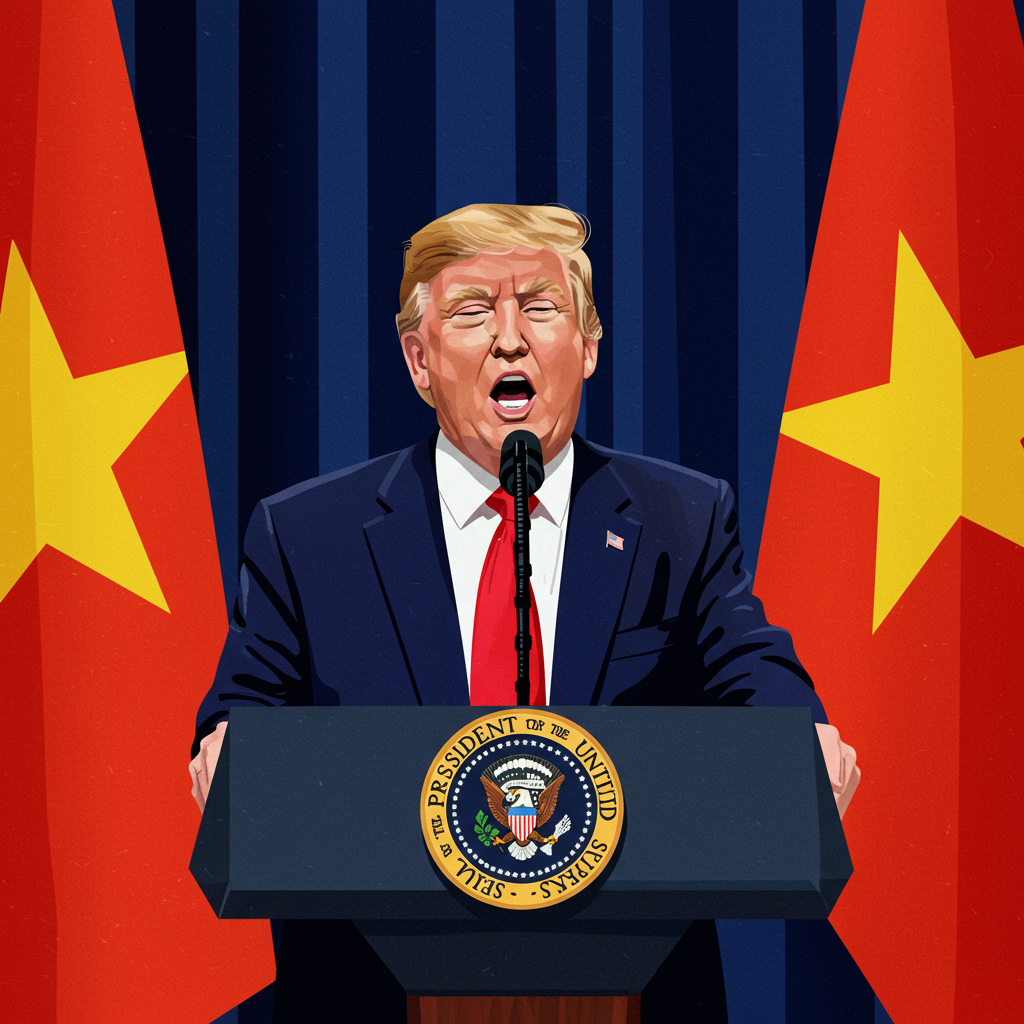A significant trade agreement has been reached between the United States and vietnam. President Donald Trump announced the pact on Wednesday following intensive, last-minute negotiations. This deal aims to recalibrate trade flows between the two nations, introducing new tariffs on Vietnamese goods entering the US while opening Vietnam’s markets to American products at zero tariff. The announcement prevents a much steeper tax on Vietnamese imports that was set to take effect imminently.
Key Terms of the New US-Vietnam Trade Agreement
Under the newly finalized deal, the United States will impose a 20% tariff on many products imported directly from Vietnam. This rate represents a substantial reduction from a previously announced 46% levy. That higher tariff was part of a broader “reciprocal” tariff strategy initiated by the Trump administration in April. The 46% rate had been suspended for 90 days, with that grace period nearing its expiration. The agreement came just ahead of this crucial deadline, preventing the larger tax from being implemented next week.
In return for the US tariffs, Vietnam has agreed to eliminate tariffs on American goods. President Trump highlighted this point in a social media post. He stated that Vietnam would provide the United States with “TOTAL ACCESS” to their markets. This means US companies can sell their products into Vietnam with no import taxes. Trump specifically mentioned he believed large engine vehicles, like SUVs popular in the US, would find success in the Vietnamese market.
Beyond the direct 20% tariff on Vietnamese products, the agreement introduces a higher 40% tariff. This steeper tax is specifically targeted at goods known as “trans-shipments.” Trans-shipping involves routing goods from a third country through Vietnam before they reach the United States. US officials, including former senior advisor Peter Navarro, have alleged that a significant portion of goods arriving from Vietnam were actually products originating from China. This practice is believed to be used to avoid US tariffs imposed on Chinese goods.
Understanding the Context: Tariffs, Trade Imbalance, and Global Shifts
Tariffs are essentially taxes levied on imported goods. While the tariff is technically paid by the importing company in the destination country, businesses often pass these additional costs onto consumers through higher prices. This potential for increased costs can negatively impact demand for goods manufactured in the exporting country. Many US trading partners have expressed concern that these tariffs could hurt their economies.
The agreement with Vietnam takes place against a backdrop of a significant trade imbalance between the two countries. Recent data from the USTR indicates a substantial trade deficit for the US with Vietnam. In 2024, US goods exports to Vietnam were $13.1 billion, while imports from Vietnam totaled $136.6 billion. This resulted in a trade deficit of $123.5 billion for the US with Vietnam, marking an 18.1% increase over the previous year. Vietnam ranks as the third-largest source of the US trade deficit, following China and Mexico.
Vietnam has become a critical manufacturing hub for numerous global brands. Companies like Nike, Apple, Gap, and Lululemon produce goods there. Vietnam benefited significantly from the US-China trade tensions during Trump’s first term. Many firms relocated factories from China to Vietnam to avoid the tariffs imposed on Chinese exports. This agreement adds a new layer of complexity for these companies navigating their supply chains.
The Transshipping Challenge and Expert Reactions
The concept of “trans-shipping” and the 40% tariff on such goods introduce significant complexities. Defining and enforcing rules around trans-shipping can be challenging. Adam Sitkoff, executive director of the American Chamber of Commerce in Hanoi, voiced concerns about the definition. He described the term as “vague and often politicised” within trade enforcement discussions. Sitkoff questioned how effectively Vietnamese officials could identify and prevent illegal re-routing or even how widespread the issue truly is.
Experts like William Reinsch, a former US trade official, also note that enforcing transshipping rules is “always complicated.” He points out the difficulty in distinguishing between outright fraud (like simply changing labels) and legitimate processes where goods undergo significant transformation in Vietnam before export. While US officials have highlighted concerns about China using Vietnam as a conduit, a February study cited in one report suggested “much less rerouting than previously believed.”
Despite the complexities, Sitkoff expressed overall optimism regarding the deal. He told the BBC World Business Report that the agreement positions Vietnam favorably. He believes companies shipping from Vietnam to the US will likely continue their operations. However, other experts, like Mary Lovely from the Peterson Institute for International Economics, suggested the deal was largely unfavorable to Vietnam. She implied Vietnam was “very keen” to avoid the earlier, higher 46% tariff, indicating the agreement might have been somewhat forced upon the smaller nation. She doubted the US could achieve such a lopsided deal with larger economies like the EU or Japan.
Broader Strategic and Economic Context
The trade deal with Vietnam unfolds amid increasing strategic importance placed on the country by the United States. Vietnam has become a key partner for the US, particularly in efforts to counterbalance China’s growing influence in the region. This strategic alignment was underscored in 2023 when Vietnam hosted both President Joe Biden and Chinese leader Xi Jinping, becoming the only country to receive state visits from both leaders in the same year. The US also upgraded Vietnam to its highest diplomatic status, a comprehensive strategic partner, placing it alongside countries like China and Russia.
Adding another layer to the relationship, the Trump family has recently announced significant business development projects in Vietnam. The Trump Organization and a local partner received approval for a $1.5 billion investment. This large-scale project near Hanoi includes plans for hotels, golf courses, and luxury real estate. Separately, the Trump Organization is reportedly scouting locations for a Trump Tower in Ho Chi Minh City. While these business ventures are distinct from government trade negotiations, their timing adds a notable dimension to the US-Vietnam relationship during this period.
The Vietnam agreement is one of the few bilateral trade deals concluded under the specific “reciprocal” tariff initiative announced by Trump in April. Following the initial steep levies and a subsequent pause at a 10% rate, many countries approached the US seeking negotiations to avoid higher tariffs. Prior to the Vietnam pact, Washington had only announced a limited agreement with Britain and a temporary deal lowering retaliatory duties with China in a separate dispute. The July 9th deadline for lifting the pause on many of the April tariffs means other countries are still scrambling to reach agreements with the US to prevent tariff increases. Vietnam’s prompt action secured a lower tariff rate than initially threatened.
Frequently Asked Questions
What are the specific tariffs agreed upon in the US-Vietnam trade deal?
The new agreement imposes a 20% tariff on most goods imported directly from Vietnam into the United States. This is a reduction from a previously threatened 46% tariff. Additionally, the deal includes a higher 40% tariff on goods identified as “trans-shipments” – products routed through Vietnam from a third country before reaching the US. In exchange, Vietnam will charge no tariffs on US products entering its market, granting the US “TOTAL ACCESS” for trade.
How does this Vietnam trade deal fit into the US’s broader tariff strategy?
This deal is a direct outcome of the “reciprocal” tariff strategy announced by the US in April. That initiative imposed steep initial tariffs but then paused them at 10% until July 9th, offering countries time to negotiate bilateral agreements. The Vietnam deal is one of the first significant agreements reached under this specific framework, alongside a limited pact with Britain and a temporary arrangement with China. It demonstrates the US administration’s approach to leverage potential high tariffs to secure concessions like market access from trading partners before the negotiation deadline expires.
What are the potential impacts of the US-Vietnam trade deal on businesses and consumers?
For businesses manufacturing in or sourcing from Vietnam, the 20% tariff means increased costs compared to previous rates, though it’s less severe than the initially threatened 46%. These costs may be absorbed by importers or passed onto US consumers via higher prices for goods like apparel, electronics, and footwear made in Vietnam. For US exporters, the zero tariff access to Vietnam’s market presents new opportunities, potentially boosting sales for products like automobiles. The complexity of enforcing the transshipping tariff could create uncertainty for supply chains relying on materials or components routed through Vietnam.
Conclusion
The trade deal announced by President Trump with Vietnam represents a significant development in bilateral relations. It establishes new tariff rates, averting a much higher tax on Vietnamese imports while securing zero-tariff access for US exports to Vietnam’s growing market. The agreement addresses the substantial trade imbalance between the two nations and attempts to curb alleged trans-shipping activities. While some experts express optimism about Vietnam’s position, challenges remain, particularly concerning the definition and enforcement of the transshipping rule. This pact serves as a notable outcome of the Trump administration’s reciprocal tariff strategy, finalised just ahead of a key deadline and set against the backdrop of Vietnam’s increasing strategic and economic importance.



